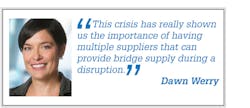One of the prime concerns raised by the COVID-19 pandemic has been the impact that plant closures and manufacturing disruptions would have on supply chains. Dawn Werry, CMO of Chief Outsiders, and Shawn Rollins, purchasing manager of Forecast 3D, discussed with Hydraulics & Pneumatics the changing supply chain and the ways it will need to evolve to meet current and future demands:
Hydraulics & Pneumatics: In the best of times, supply chain efficiencies often get overlooked when companies look at continuous improvement. What are some of the most common supply chain opportunities for improvement?
Shawn Rollins: Companies can bring the supply chain closer to home—either within the country or even local. That allows a shorter lead time, often less than a week, and quality control is easier. For instance, we have a number of local suppliers, so in normal times, I can easily go to their site to confirm quality control.
Dawn Werry: This crisis has really shown us the importance of having multiple suppliers that can provide bridge supply during a disruption. Get them approved and on your preferred vendor list ahead of time so you can efficiently move to other suppliers if needed.
H&P: Under the unique situation of the coronavirus outbreak, supply chains have been disrupted. What should manufacturers do to address these challenges?
DW: Rethink your supply chain. Look for nontraditional ways to get raw materials or produce goods. For instance, in normal times, additive manufacturing might not be the right way for you to get parts. But suppliers like Forecast 3D can often turn around parts in as little as a day, so it can effectively bridge the gap for a customer who just needs enough volume to get through the crisis.
Another example comes from when I worked in the chemical industry. We could often purchase materials from other companies, rather than making it ourselves. It might cost more in the short term, but it could keep us operating.
H&P: What work should manufacturing leaders do now to evaluate and improve supply chain operations?
SR: This is an opportunity to work on some of the things that improve your operations. Great examples are lean manufacturing, safety and improving the process flow in the shop. It is also a good time to organize and catch up on training.
DW: It’s also an opportunity to focus on your customers. Their needs are changing, and you may be able to reconfigure what you make and how you operate to provide them with much-needed solutions. While many functions talk to customers regularly, this can be a time to loop operations into that conversation.
H&P: Plants also have an internal supply chain. Are there opportunities to review and improve the material flow within the plant?
SR: Most definitely! I would use the downtime to think about our internal customers, as I call them. It’s a good time to learn about their issues and review our project flow between departments.
DW: In addition to internal workflow, it’s a good time to consider how market demand affects production processes. I worked with a company that made fabrics for the military. When demand was especially high from the military, we had to prioritize our remaining allocations to the private sector. Of course, our production team worked to increase capacity, but they also met daily with our customer-facing teams to determine how to best allocate the supply we had so we could meet the needs of the military and still service our private sector customers.
H&P: And manufacturers increasingly are part of an external supply chain. What can they do to be a better supply chain partner when the crisis is over?
SR: Without a doubt, communication is key. During a crisis, most customers will be understanding about supply chain issues as long as they know what’s happening. Work with them to get them everything that’s possible to deliver. Understand what’s critical to have so you can balance their needs against your capabilities.
DW: I agree. Communicate how and when things will happen so there are no surprises for your customers.
About the Author
Bob Vavra
Senior Content Director, Power & Motion and Machine Design
Bob Vavra is the Senior Content Director of Power & Motion and its sister publication Machine Design. Vavra has had a long career in publishing, media and events. He has covered all aspects of manufacturing for the past 20 years and is a regular attendee at events such as IMTS and Hannover Messe. Vavra is also a sought-after webcast moderator and event emcee, and has presided over events in the U.S., Germany and China.

Leaders relevant to this article:

